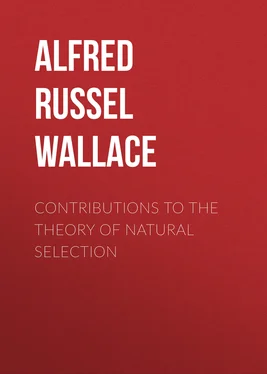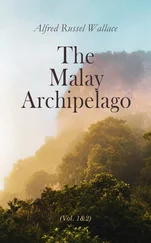Alfred Wallace - Contributions to the Theory of Natural Selection
Здесь есть возможность читать онлайн «Alfred Wallace - Contributions to the Theory of Natural Selection» — ознакомительный отрывок электронной книги совершенно бесплатно, а после прочтения отрывка купить полную версию. В некоторых случаях можно слушать аудио, скачать через торрент в формате fb2 и присутствует краткое содержание. Жанр: foreign_prose, foreign_edu, foreign_antique, на английском языке. Описание произведения, (предисловие) а так же отзывы посетителей доступны на портале библиотеки ЛибКат.
- Название:Contributions to the Theory of Natural Selection
- Автор:
- Жанр:
- Год:неизвестен
- ISBN:нет данных
- Рейтинг книги:4 / 5. Голосов: 1
-
Избранное:Добавить в избранное
- Отзывы:
-
Ваша оценка:
- 80
- 1
- 2
- 3
- 4
- 5
Contributions to the Theory of Natural Selection: краткое содержание, описание и аннотация
Предлагаем к чтению аннотацию, описание, краткое содержание или предисловие (зависит от того, что написал сам автор книги «Contributions to the Theory of Natural Selection»). Если вы не нашли необходимую информацию о книге — напишите в комментариях, мы постараемся отыскать её.
Contributions to the Theory of Natural Selection — читать онлайн ознакомительный отрывок
Ниже представлен текст книги, разбитый по страницам. Система сохранения места последней прочитанной страницы, позволяет с удобством читать онлайн бесплатно книгу «Contributions to the Theory of Natural Selection», без необходимости каждый раз заново искать на чём Вы остановились. Поставьте закладку, и сможете в любой момент перейти на страницу, на которой закончили чтение.
Интервал:
Закладка:
It is also well known that animals in a state of nature produce white varieties occasionally. Blackbirds, starlings, and crows are occasionally seen white, as well as elephants, deer, tigers, hares, moles, and many other animals; but in no case is a permanent white race produced. Now there are no statistics to show that the normal-coloured parents produce white offspring oftener under domestication than in a state of nature, and we have no right to make such an assumption if the facts can be accounted for without it. But if the colours of animals do really, in the various instances already adduced, serve for their concealment and preservation, then white or any other conspicuous colour must be hurtful, and must in most cases shorten an animal’s life. A white rabbit would be more surely the prey of hawk or buzzard, and the white mole, or field mouse, could not long escape from the vigilant owl. So, also, any deviation from those tints best adapted to conceal a carnivorous animal would render the pursuit of its prey much more difficult, would place it at a disadvantage among its fellows, and in a time of scarcity would probably cause it to starve to death. On the other hand, if an animal spreads from a temperate into an arctic district, the conditions are changed. During a large portion of the year, and just when the struggle for existence is most severe, white is the prevailing tint of nature, and dark colours will be the most conspicuous. The white varieties will now have an advantage; they will escape from their enemies or will secure food, while their brown companions will be devoured or will starve; and as “like produces like” is the established rule in nature, the white race will become permanently established, and dark varieties, when they occasionally appear, will soon die out from their want of adaptation to their environment. In each case the fittest will survive, and a race will be eventually produced adapted to the conditions in which it lives.
We have here an illustration of the simple and effectual means by which animals are brought into harmony with the rest of nature. That slight amount of variability in every species, which we often look upon as something accidental or abnormal, or so insignificant as to be hardly worthy of notice, is yet the foundation of all those wonderful and harmonious resemblances which play such an important part in the economy of nature. Variation is generally very small in amount, but it is all that is required, because the change in the external conditions to which an animal is subject is generally very slow and intermittent. When these changes have taken place too rapidly, the result has often been the extinction of species; but the general rule is, that climatal and geological changes go on slowly, and the slight but continual variations in the colour, form, and structure of all animals, has furnished individuals adapted to these changes, and who have become the progenitors of modified races. Rapid multiplication, incessant slight variation, and survival of the fittest—these are the laws which ever keep the organic world in harmony with the inorganic, and with itself. These are the laws which we believe have produced all the cases of protective resemblance already adduced, as well as those still more curious examples we have yet to bring before our readers.
It must always be borne in mind that the more wonderful examples, in which there is not only a general but a special resemblance—as in the walking leaf, the mossy phasma, and the leaf-winged butterfly—represent those few instances in which the process of modification has been going on during an immense series of generations. They all occur in the tropics, where the conditions of existence are the most favourable, and where climatic changes have for long periods been hardly perceptible. In most of them favourable variations both of colour, form, structure, and instinct or habit, must have occurred to produce the perfect adaptation we now behold. All these are known to vary, and favourable variations when not accompanied by others that were unfavourable, would certainly survive. At one time a little step might be made in this direction, at another time in that—a change of conditions might sometimes render useless that which it had taken ages to produce—great and sudden physical modifications might often produce the extinction of a race just as it was approaching perfection, and a hundred checks of which we can know nothing may have retarded the progress towards perfect adaptation; so that we can hardly wonder at there being so few cases in which a completely successful result has been attained as shown by the abundance and wide diffusion of the creatures so protected.
Objection that Colour, as being dangerous, should not exist in Nature
It is as well here to reply to an objection that will no doubt occur to many readers—that if protection is so useful to all animals, and so easily brought about by variation and survival of the fittest, there ought to be no conspicuously-coloured creatures; and they will perhaps ask how we account for the brilliant birds, and painted snakes, and gorgeous insects, that occur abundantly all over the world. It will be advisable to answer this question rather fully, in order that we may be prepared to understand the phenomena of “mimicry,” which it is the special object of this paper to illustrate and explain.
The slightest observation of the life of animals will show us, that they escape from their enemies and obtain their food in an infinite number of ways; and that their varied habits and instincts are in every case adapted to the conditions of their existence. The porcupine and the hedgehog have a defensive armour that saves them from the attacks of most animals. The tortoise is not injured by the conspicuous colours of his shell, because that shell is in most cases an effectual protection to him. The skunks of North America find safety in their power of emitting an unbearably offensive odour; the beaver in its aquatic habits and solidly constructed abode. In some cases the chief danger to an animal occurs at one particular period of its existence, and if that is guarded against its numbers can easily be maintained. This is the case with many birds, the eggs and young of which are especially obnoxious to danger, and we find accordingly a variety of curious contrivances to protect them. We have nests carefully concealed, hung from the slender extremities of grass or boughs over water, or placed in the hollow of a tree with a very small opening. When these precautions are successful, so many more individuals will be reared than can possibly find food during the least favourable seasons, that there will always be a number of weakly and inexperienced young birds who will fall a prey to the enemies of the race, and thus render necessary for the stronger and healthier individuals no other safeguard than their strength and activity. The instincts most favourable to the production and rearing of offspring will in these cases be most important, and the survival of the fittest will act so as to keep up and advance those instincts, while other causes which tend to modify colour and marking may continue their action almost unchecked.
It is perhaps in insects that we may best study the varied means by which animals are defended or concealed. One of the uses of the phosphorescence with which many insects are furnished, is probably to frighten away their enemies; for Kirby and Spence state that a ground beetle (Carabus) has been observed running round and round a luminous centipede as if afraid to attack it. An immense number of insects have stings, and some stingless ants of the genus Polyrachis are armed with strong and sharp spines on the back, which must render them unpalatable to many of the smaller insectivorous birds. Many beetles of the family Curculionidæ have the wing cases and other external parts so excessively hard, that they cannot be pinned without first drilling a hole to receive the pin, and it is probable that all such find a protection in this excessive hardness. Great numbers of insects hide themselves among the petals of flowers, or in the cracks of bark and timber; and finally, extensive groups and even whole orders have a more or less powerful and disgusting smell and taste, which they either possess permanently, or can emit at pleasure. The attitudes of some insects may also protect them, as the habit of turning up the tail by the harmless rove-beetles (Staphylindidæ) no doubt leads other animals besides children to the belief that they can sting. The curious attitude assumed by sphinx caterpillars is probably a safeguard, as well as the blood-red tentacles which can suddenly be thrown out from the neck, by the caterpillars of all the true swallow-tailed butterflies.
Читать дальшеИнтервал:
Закладка:
Похожие книги на «Contributions to the Theory of Natural Selection»
Представляем Вашему вниманию похожие книги на «Contributions to the Theory of Natural Selection» списком для выбора. Мы отобрали схожую по названию и смыслу литературу в надежде предоставить читателям больше вариантов отыскать новые, интересные, ещё непрочитанные произведения.
Обсуждение, отзывы о книге «Contributions to the Theory of Natural Selection» и просто собственные мнения читателей. Оставьте ваши комментарии, напишите, что Вы думаете о произведении, его смысле или главных героях. Укажите что конкретно понравилось, а что нет, и почему Вы так считаете.












